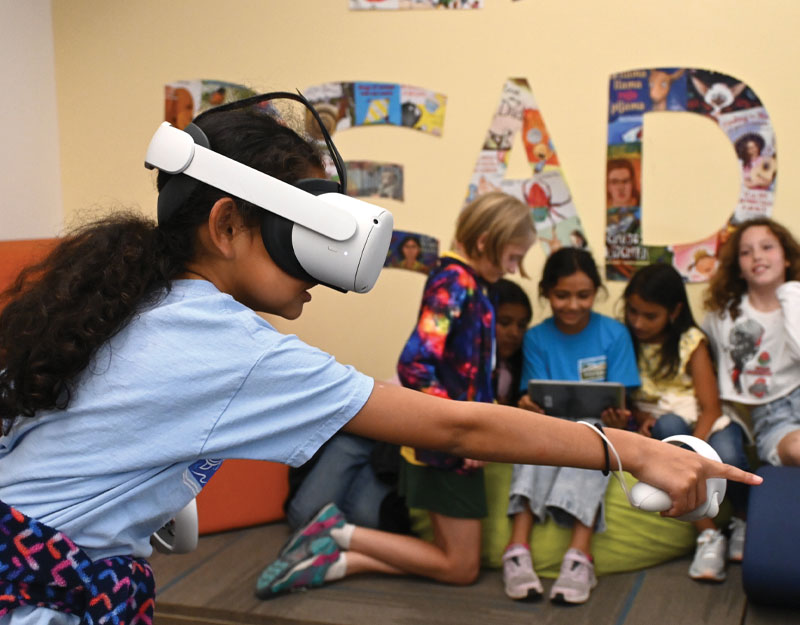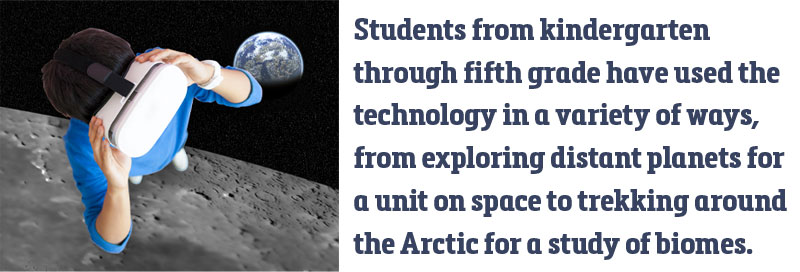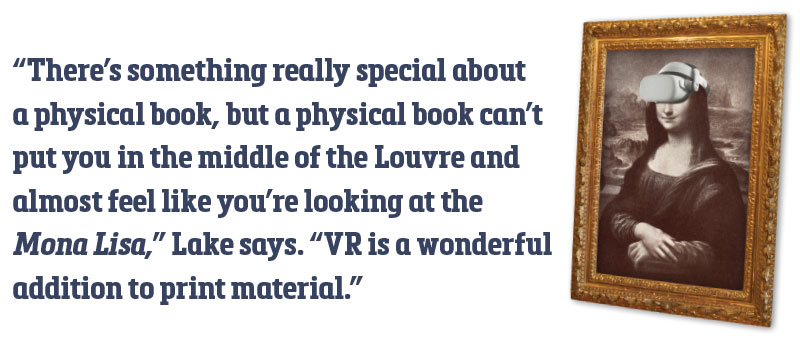From Job Exploration to Geography, AR and VR Lift Student Learning
School librarians are finding unique ways to integrate the technology in nearly every unit of study. Virtual field trips are only the tip of the iceberg for how this tech can impact learning.
 |
A Student At Flowery Elementary School In Sonoma, Ca, Uses An Oculus Rift Headset As Classmates View The Action Casting To An Ipad.Photo courtesy of Sara Hubbard Lake |
Piscataquis County in central Maine is the state’s poorest and least populated, but for the roughly 400 students at rural Piscataquis Community Elementary School, they’ve visited parts of the world most students their age can only dream about.
That’s because Piscataquis is home to one of the only fully immersive 360-degree classrooms in New England. Nicknamed the “Pirate Portal” after the school’s mascot, the learning environment is equipped with multiple projectors that create a seamless panoramic experience, allowing students to swim with sharks and explore distant planets.
“Our students are underexposed,” says Kathy Jarret, the district’s library media specialist who also teaches computer science at Piscataquis. “Some students have never been to the ocean, even living in Maine. This technology has really allowed us to show them the world.”
Jarret also uses augmented reality (AR) and virtual reality (VR) technology for everything from lessons to read-alouds and virtual roller coaster rides as a reward for students. Although the school has only been using the technology for a year, Jarret has already seen positive results.
“We’ve really demonstrated some increased learning outcomes,” she says. “Better retention of facts, greater attention to detail, and just greater engagement. Students love going down to the portal and seeing what they are going to experience.”
School librarians around the country are finding unique, exciting ways to integrate the technology in nearly every unit of study, with students as young as kindergarten all the way through high school. Virtual field trips are only the tip of the iceberg for how this tech can impact learning.
In the classroom, immersive technology can extend student learning beyond the physical environment. AR typically uses a smartphone or a tablet to overlay a real-world setting with digital elements, like special effect filters in TikTok or mobile games like Pokémon GO. VR, on the other hand, completely replaces the physical world with digital audio and visuals that users experience through goggles or headsets, like Google Cardboard and Oculus Rift.
Marcia A. Mardis, professor at the College of Communication & Information at Florida State University, says AR and VR “open up the kinds of experiences learners can have to an unprecedented level.”
As one of the lead writers of the National School Library Standards for Learners, School Librarians, and School Libraries, Mardis says the immersive tech can enhance student learning by creating virtual spaces where students explore unfamiliar situations and build and apply knowledge through those experiences. In the library, AR and VR can create new connections between traditional text and resources.
AR and VR also offer “additional access points for students with different learning styles and who come to the resource for different reasons,” says Kay Oddone, course director and lecturer in teacher librarianship at Charles Sturt University in Australia.
Librarians and students can use an application like Halo AR or EyeJack AR to create a marker—like a QR code—that, when scanned by an iPad or phone camera, links to any number of multimedia resources to extend learning.
“A small QR code label on a book could link to a video of a fellow student giving a book talk about the title, guide readers to a playlist of music to listen to while reading a particular title, or even direct readers to a digital pathfinder or curated collection of resources about the author or other publications they might be interested in,” Oddone says.
Librarians—who are often a district’s tech leaders—can play a crucial role in helping students and teachers get the most out of the technology.
“Does the tech help advance learning for students, or is it just really cool?” asks Carrie Betts, the school librarian at West Maple Elementary School in Bloomfield Hills, MI. “We have to think about that, but once we find it, our job is to learn it ourselves, learn the kinks, the trainwrecks, and then bring it to the classroom.”

A digital passport
Betts has had a lot of experience with both the trainwrecks and successes of using VR with students. During the 2017–18 school year, Betts secured 30 VR goggles, along with paired phones and tablets, thanks to a grant from a local education foundation and donations from the school’s PTA. Since then, VR has been transformative in introducing new topics and building student excitement.
“Any time we bring out the VR goggles, we don’t have to worry about engagement,” Betts says.
Students from kindergarten through fifth grade have used the technology in a variety of ways, from exploring distant planets for a unit on space to trekking around the Arctic for a study of biomes. One of Betts’s favorite uses of VR was for a unit on Jane Goodall. Students “walked” in the very forests of Tanzania where the primatologist conducted her behavioral studies of wild chimpanzees.
VR does have its limitations, especially with younger students. In Betts’s library, students cannot walk around while using goggles, since they could easily trip or run into classmates. They must take breaks, since long exposure can cause sore eyes and headaches. And while plenty of learning happens during their virtual trips, perhaps the most important learning occurs back in the real world when students talk with one another about what they saw.
“The discussion afterwards is really the meaningful piece,” says Betts, whose library was named the National School Library of the Year by the American Association of School Librarians in 2023. “What did you see in VR that changed your thinking about something you already knew? Or what’s new that you didn’t expect to learn? What did you take away? The turn-and-talk with their neighbor is the rich part.”
Sixth-grade science teacher Justin Kosek tried VR for the first time this past school year with his students in the West Allis-West Milwaukee (WI) school district, elevating his traditional unit on the water cycle with the help of Oculus Quest 2 headsets and a virtual coding program called Zoe.
Working in pairs, students brainstormed ideas for an educational video game that explored a part of the water cycle. Then, students worked on creating story boards of their video games before building their scenes and characters, swapping spending about 15 minutes working in the headset while their partner collaborated alongside on an iPad.
“After a couple of days, sixth grade students were doing things more advanced than I could,” Kosek says. “That was one of the things that made it fun for them, because they could teach me, and my excitement was there because I was so blown away by what they were doing and creating,” like a video game two students made where the hero had to defeat a dragon that was disrupting the water cycle because its fire was evaporating water too quickly.
Student collaboration and problem solving was “unlike anytime I’d ever taught,” Kosek says, adding that students also displayed deeper understanding of concepts, recalling information weeks after their project, and were far more engaged than during a typical class. While his school often struggles with attendance issues, during the VR unit attendance was up in Kosek’s classroom.
“Students weren’t skipping class,” Kosek says. “They were coming on time, and within five minutes of the bell they were ready to go. Engagement was also higher, because that’s all students were talking about, even with their families at home, and families were feeling connected because kids were coming home and saying how excited they were.”
Next year Kosek takes on a new role as the district’s Innovation Coach, while he’ll also run the library and manage technology. Already teachers have reached out to him about incorporating VR into their classrooms.
Still, he says everything wasn’t perfect; there were tech issues. At the start of his water cycle unit, Kosek and his students often faced days when they couldn’t even use their headsets, until finally the school’s IT department discovered the web filter that was to blame. But none of those hurdles deflated Kosek and his students’ enthusiasm for VR.
Bringing AR and VR to a school or library doesn’t have to be a major undertaking. Library media specialist Sara Lake has only two headsets available for her students at Flowery Elementary in Sonoma, CA. The headsets are so popular, Lake holds a lottery to see which students can use them, mostly during recess and after school.
Although Lake calls herself a “paper-and-pen person” and sees VR as a supplement to traditional resources, she loves the freedom it brings to students, from tools like Brink, which lets students visit national parks, to Ocean Rift, which takes them to underwater habitats.
“There’s something really special about a physical book, but a physical book can’t put you in the middle of the Louvre and almost feel like you’re looking at the Mona Lisa,” Lake says. “VR is a wonderful addition to print material.”

Meeting students’ needs
Teachers and librarians can also use the technology in ways that hit closer to home. “We all talk about meeting students where they are, and this tech gives us an additional way to do that,” Mardis says.
Back in Maine’s Piscataquis Community Elementary School, Jarret found some unique uses. During the school’s social-emotional learning time, she’s had students use ClassVR headsets to enter virtual sensory rooms to relax with soothing lights and the sound of rain. Jarret also partnered with the school’s art teachers to create an immersive experience of student art, similar to the Van Gogh Exhibit. Parents could virtually explore the gallery.
The tech can also support students with unique learning needs, including English language learners (ELL). At West Maple Elementary in Michigan, the school is also home to elementary students from the French School of Detroit. With a large French-speaking population, students are clustered within every class, and VR has been a way to bridge the language divide.
“Because it is visual, our ELL students can have a shared experience with the class,” Betts says. “They can see what we’re talking about, and that makes it very different than me just talking.”
In Danvers, MA, the district’s former technology director, Jeff Liberman, used a 360-degree camera and student videographers to create a virtual tour of the middle school, providing a low-stress way for elementary students to preview their new classrooms. For another project, the district created a virtual tour of the city’s downtown for special education students taking a life skills class in preparation for independent living.
VR has also proven useful in workforce development. Erica Trowbridge, a library media specialist at Oakridge Public Schools in Muskegon, MI, used a job simulator with her special education students to try out what it would be like to work in a variety of settings, like a restaurant and a mechanic’s shop.
“The kids really love that,” Trowbridge says. “It gets them away from the rigor and the grind of the classroom.” Not only can students use VR to learn about potential careers, but virtual job simulators can even prepare students for job interviews and to learn new skills. Transfr is an immersive tech startup that provides virtual career exploration and training in fields including construction, aviation, and manufacturing
Beyond the classroom, Mardis is intrigued by how AR can be used to preserve communities’ cultural heritage.
“If you think about how a lot of historic buildings are getting taken down or obscured in other ways, people are making local tours with AR to see what used to be there,” she says. “That’s really helping to preserve the human record.”
Several apps are already bringing this idea to life. Kinfolk allows users to bring monuments of underrepresented Black and brown historical figures to virtual life, while Historik shows physical locations in their original spot.
Examples like these are why Mardis is excited about AR and VR’s capacity to help students overcome obstacles to learning—including financial limitations and geographic restrictions.
“AR and VR have this real leveling quality, this equalizing potential, for these tools to give kids experiences they might not be able to access in their own lives,” she says. “I really like that.”
Source art for SLJ montage: DrRave (outer space); recep-bg (teen with headset). Both Getty Images.
Mona Lisa: Grafissimo/Getty Images. Headset: ilkercelik/Getty Images
Andrew Bauld is a freelance education reporter.
The job outlook in 2030: Librarians will be in demand
The job outlook in 2030: Librarians will be in demand
ALREADY A SUBSCRIBER? LOG IN
We are currently offering this content for free. Sign up now to activate your personal profile, where you can save articles for future viewing






Add Comment :-
Be the first reader to comment.
Comment Policy:
Comment should not be empty !!!